Sprout-Bauer (later acquired by Andritz) – Muncy, PA 1988–1989
Process Engineer
Performed and documented detailed heat and material balances. Created flow diagrams and instrumentation schemes for several types of mechanical pulping systems.
- Performed quality and operational audits at several North American paper mills.
- Recommended process improvements.
- Assisted in start-up and troubleshooting of instrumentation and process equipment.
When I worked for Sprout-Bauer, now a division of Andritz, they made some of the same feedstock equipment they make today but their main business was providing capital equipment for the pulp and paper industry. This was mostly in the form of turnkey thermo-mechanical pulping lines that turned wood chips into the pulp that was fed to paper-making machines. At the time the biggest machines were cranking out newsprint in 20-foot wide spools at 60 miles an hour but different lines made tissue and other products. Older, smaller lines tended to be repurposed to produce specialty paper products in smaller volumes. I once saw a decades-old old screw dewatering press that no longer had its metal cover. The workers had hung rods with shower curtains along each side to catch any stray squirts. It was fun to take a picture of it back to the engineer who designed it. He was one of those classic guys that had been around forever, had designed everything, and had an entire drawer full of patents.
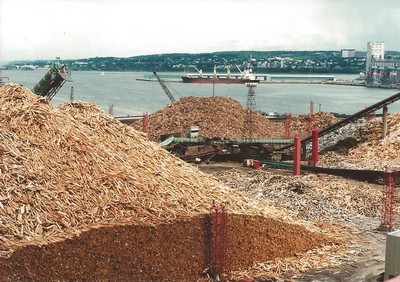
This giant woodpile is visible from the Chateau Frontenac in beautiful Quebec City.
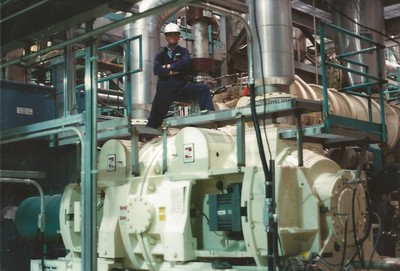
These 22,000 horsepower mechanical refiners do most of the work.
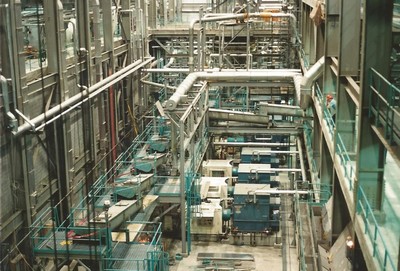
The facilities can be quite extensive. Other banks of equipment are located on the various side decks.
As a process engineer I didn't have to know how the machines and the controls worked in much detail, my job was to learn all I could about the many empirical properties of wood pulp as it was transformed into the desired product. I spent my first month working in the company's lab in Springfield, OH to get the basics down. I shoveled chips and refined pulp around and generally kept up a good humor as the two shop technicians had their fun showing me how everything worked. Then the folks in the lab showed me how they tested pulp samples from different phases of the process and I learned about the detailed measurements that were taken. Many field visits involved collecting bucketfuls of samples over the course of many hours (to eliminate short-term variations), dewatering them in the on-site lab, packing them in bags and boxes, and shipping them back to Springfield.
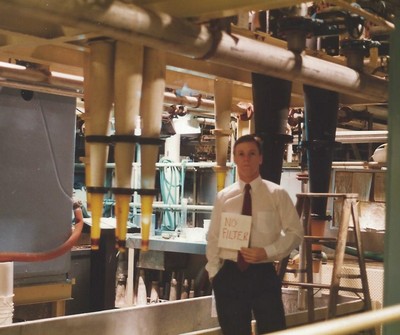
Selfie on the shop floor by banks of centrifugal cleaners. I'm trying to figure out which filters make the pictures look decent in the crazy lighting, but I didn't get the focus quite right.
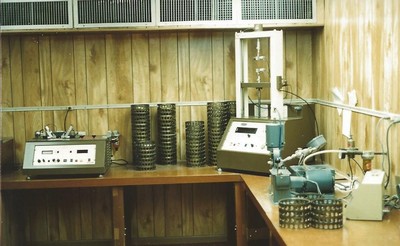
Once the samples rounds were made they had to sit overnight in a climate-controlled room before the tests could be run.
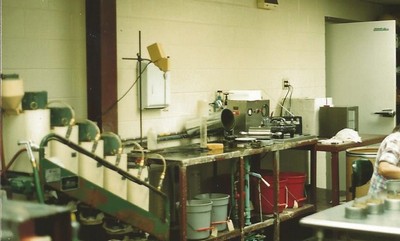
Some tests were run on the raw pulp itself. No climate control was needed.
Once I moved to the main office in Muncy, PA I had two main duties. One was to prepare system drawings and heat and material balances for proposed pulping systems. This involved figuring out how much wood material and how much water and steam at what temperature and pressure needed to move through each process in order to produce the proposed volume of pulp at the paper machine. This information drove the sizing and quantity of the individual pieces of process equipment and piping that would need to be installed, and of course the cost and maintenance profile. I worked with the drafting department to get the many sheets of process drawings together and then annotated the drawings with the heat and material balance information and the basic instrumentation scheme. The other duty was to go out to plants and either demonstrate that they were meeting their throughput and quality guarantees or to examine some part of their process so that improvements might be recommended.
The systems themselves consisted of different sets of equipment meant to separate metal and stones and other junk from the wood chips, steam or soak or otherwise pre-process the chips, convert the chips into pulp, sort the pulp into different size classifications so bits that were still out of spec could be looped around for further refinement, bleach or otherwise process the pulp, and add water to supply the product to the headbox at the paper machine at the proper consistency. Sprout made most of the equipment on its own but incorporated equipment from other vendors as well. If I recall correctly, the guy who owned the company that made Hooper screens (one of the pulp classification devices) was working at Sprout as a VP when I was there.
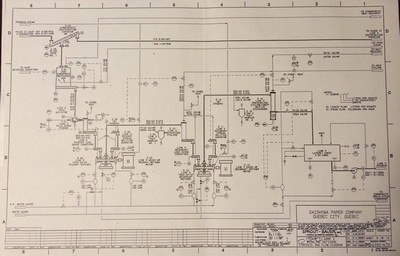
My first trip was to Corner Brook, Newfoundland, of all places. In January. Yeah it was pretty much like you'd think it would be. It was cold. I mean really cold, and there was a lot of snow. The barkeep in the hotel was an older lady holding court with a gaggle of male patrons and I have the impression that she could out-drink and out-cuss all of them, though I doubt that's what was actually happening. I got to go to somewhat easier climes on Vancouver Island, Quebec City (for my money one of the most beautiful places in North America), Saint John, New Brunswick, Shawinigan, Quebec, Catawba, SC, and Grenada, MS. For a new engineer it was all quite an adventure, even if most of the destinations were in out-of-the-way places.
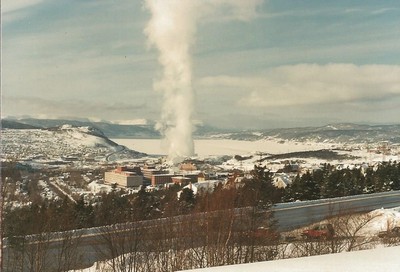
My first trip was to Corner Brook, Newfoundland. In January!
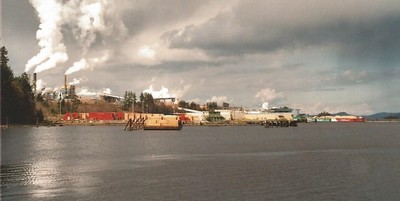
Crofton, British Columbia, on Vancouver Island, was a bit more scenic, and certainly warmer, by springtime.
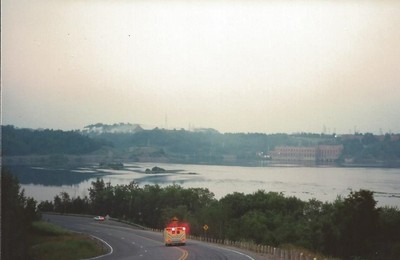
I visited the quiet region of Shawinigan, Quebec on several occasions to verify that a new installation was meeting its throughput and quality targets.
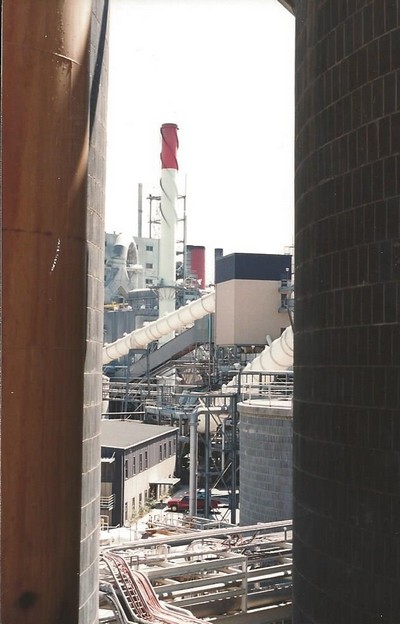
An eighty-foot-high steam condenser was clogging with scale at this plant in South Carolina. It was interesting to climb around inside that thing.
The control systems were still largely pneumatic at the time and consisted mostly of local control loops. The HMIs (Human-Machine Interfaces) were also pretty basic and were all developed by hand. I met some of the control systems guys and remember that they always looked tired and seemed to stay in the field a lot. I few years later I would learn all about what they were going through...
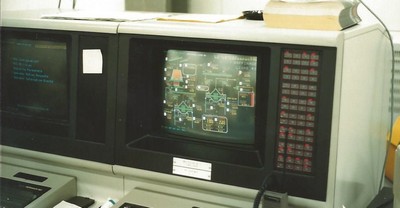
HMIs of the period were highly customized and manually generated.
This was a great first engineering job for a number of reasons. Most importantly I worked for and with some really good people, particularly my direct supervisor, Brad Cort. I traveled with him quite a lot and learned about the paper industry and also about life in general. One of the other great things the process engineering department did was circulate piles of magazines, papers, articles, and other interesting information about the industry (see example). I was always interested in personal computers and programming and was continuously devouring multiple magazines every month but the industry information was fascinating. I'm not sure whether that was just part of the culture of that company or whether it was something many people in the industry needed to do, but it gave me the feeling that the company was doing all it could to prepare its people. The company also sent its people to training courses sponsored by various industry associations. During a memorable week in Toronto several people shared their interesting findings with the ultra-connected Mr. Cort.
I remember particular findings having to do with required energy input being seasonal (it takes more energy in the winter because the feed materials are colder and need to be heated up more) and the "condom" effect, where fibers in thermo-mechanical refiners line up perpendicular to the teeth on the refiner plates, and the outer layers get peeled/rolled off each fiber lengthwise like a condom. By contrast, the fibers in stone groundwood processing are peeled off in parallel to the axis of the grinding stone. That is, refiners shred fibers along their length, grinding stones shred fibers perpendicular to their length. There was sooo much specific tradecraft to learn... I had learned enough by the time I attended that conference that when we broke up into groups to propose solutions to sample process problems my suggestions enabled our group to win the prize for the refiner-pulping exercise.
A process engineer needed to have immense amounts of qualitative knowledge but also needed a good grasp of thermodynamics and basic fluid mechanics. This was important for understanding of required energy inputs, equipment sizing, and so on. I filled many pages of unlined B-sized paper with the calculus needed to carry out the calculations I learned from my senior colleagues, along with learning how to employ them to solve different problems in my own way. I found this experience to be highly enjoyable and it set me up perfectly for my next job. Along the way we also used a simulation package called GEMS (General Energy and Material-Balance Computer System). It took a formatted text file that defined a series of nodes and connections and the operations that were to take place in the system. A more senior colleague and I used it to model a couple of systems, though we did not completely understand how it worked. I enjoyed this aspect of the job, and this work set me up perfectly for my next job, where I would learn how GEMS worked and a lot more.
I took extra computing courses when I was getting my mechanical engineering degree at Carnegie Mellon University and as you can guess the instruction there was top notch. Pascal was the main teaching language at the time so when I made the major investment in a PC while I was in the Army, I made sure to pick up a copy of Turbo Pascal 3.0. I spent quite a bit of time writing programs and building my skills during that time and while I was working for Sprout. I also got very familiar with tools like Quattro Pro (a spreadsheet), Professional Write (a pre-WYSIWYG word processor), DBase III+, DesqView, and PC Tools.
I was also introduced to the concepts of Total Quality Management when the company began teaching and implementing its recommendations. The metric our department adopted to track and improve was the number of times drawings had to be revised before final approval. Proving that you often don't learn some lessons until reconsidering things years later, I remember being frustrated by the fact we sometimes required so many iterations. There were some minor errors that we could occasionally have prevented but for the most part doing the drawings over and over as part of ongoing negotiations and design cycles was pretty much the point of my existence. The senior people hashed out the designs and the junior people updated the calculations and drawings.
It reminded me of my frustrations with not being able to make it through the dinner rush without the manager's help when I worked as a short order cook in high school. The chain was in the process of going out of business, they had reduced the staff from two cooks per shift down to one, and nobody expected a single cook to be able to handle the meal rush without help. It has since become one of my goals to ensure that the people I work with know what the context and expectations actually are so they do not experience undue tension. That kind of thing can cost a company good people.

